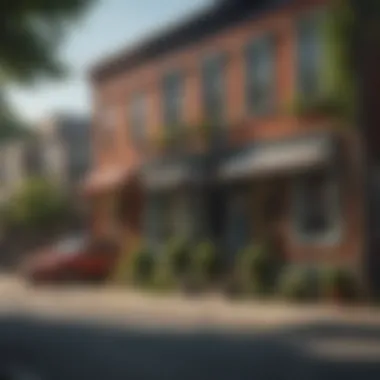Exploring the Essence of Living in D.C.


Intro
Living in Washington, D.C. encompasses a rich tapestry of experiences and environments. It is a city known not just for its political significance but also for its dynamic culture and historical depth. As the capital of the United States, D.C. blends national pride with local spirit. Residents find themselves in a city steeped in history, yet remarkably contemporary.
This guide presents a detailed exploration of the essence of life in D.C. by examining three critical aspects: the homes that define its neighborhoods, the vibrant locations that offer culture and community, and the lifestyle that shapes inhabitants’ daily experiences.
With an increasingly competitive real estate market, understanding the unique architectural styles and the cultural landmarks that mark D.C. is essential. Whether you are considering a move, seeking to enhance your knowledge of urban living, or simply desiring to understand the complex nature of this city, this article serves as an indispensable resource.
Understanding Washington, D.C.
Living in Washington, D.C., is more than a mere geographical choice; it represents a unique blend of culture, history, and current affairs. This section sheds light on the essence of D.C. by exploring its historical context and the significance it holds as the capital of the United States. Understanding these facets is vital for everyone, whether they are prospective residents, visitors, or simply those who wish to grasp the nuanced identity of the nation’s capital.
A Brief Historical Background
Washington, D.C., has a rich and multifaceted history that dates back to its founding in 1790. Chosen for its strategic position between the Northern and Southern states, it symbolizes a compromise that was crucial for the newly formed United States. Initially planned by Pierre Charles L’Enfant, the city’s layout emphasizes open spaces and grand avenues. President George Washington himself played a pivotal role in its development.
Over the decades, the city has witnessed significant events, from hosting pivotal discussions during the American Revolution to enduring the upheaval of the Civil War. The reconstruction period saw a boom in architectural style, with neoclassical buildings that now define its skyline. Such landmarks, including the Capitol Building and the White House, reflect not just architectural choices of their time but also the political struggles and triumphs of the nation.
Understanding D.C.’s history, including the civil rights movement that took center stage in the mid-20th century, provides insights into the city’s evolving identity and the voices that have shaped its narrative.
The Significance of the Capital
D.C. is not merely a political center; it represents a complex amalgamation of culture, history, and social dynamics. As the home of numerous monuments, museums, and federal institutions, the capital attracts millions of visitors each year. Key locations, like the National Mall, embody the essence of American democracy and history, making them significant not only for residents but for tourists seeking to connect with the country’s heritage.
The city’s political influence is undeniable. It serves as the epicenter for legislation and decision-making, affecting not only the nation but often international affairs as well. Thus, prospective residents should pay attention to how the fluid political climate can shape daily life in D.C., impacting everything from employment opportunities to housing.
Furthermore, D.C. is a melting pot with diverse cultural traditions. This diversity enriches the social fabric of the city, offering various communities vibrant engagement opportunities and dialogues.
"Washington D.C. is a living museum; every street has a story and every building has a history."
To summarize, by gaining a well-rounded understanding of Washington, D.C., individuals can appreciate better the melding of historical significance and contemporary relevance, thus enhancing their experience whether they choose to live, work, or visit here.
Architectural Landscape
The architectural landscape of Washington, D.C. is a vital part of what makes the city unique. It informs the character and experience of its residents and visitors. Various building styles tell stories of America’s past, traditions, and aspirations. This section examines the importance of these structures, exploring how they enhance daily living and contribute to the city’s identity.
Notable Building Styles
Washington, D.C. showcases a rich tapestry of architectural styles. From neoclassical to modern designs, each building offers a glimpse into different eras.
- Neoclassical: This style is perhaps the most recognizable in D.C., with structures like the Lincoln Memorial and the Capitol building. These grand designs reflect the influence of ancient Greece and Rome, symbolizing democratic ideals.
- Georgian: Characterized by symmetry and classic proportions, Georgian buildings such as the White House exude a sense of permanence.
- Modern: Structures like the Kennedy Center showcase sleek lines and functional design, representing the evolution of American architecture.
- Art Deco: The vibrant and geometric designs seen in some buildings add a unique flair to the city’s architectural narrative.
The diversity in styles not only offers aesthetic appeal but also serves practical functions. For instance, many buildings are designed to withstand the elements, ensuring longevity.
Preservation Efforts
Preservation of D.C.’s architectural heritage is crucial. The city has numerous efforts in place to maintain the integrity of its structures while accommodating growth.
- Historical Designation: Many buildings are protected by local ordinances. This helps control alterations, ensuring that the original character is kept intact.
- Community Engagement: Local organizations often engage residents in discussions about preservation priorities, fostering a sense of community ownership over local history.
- Adaptive Reuse: Some old buildings are repurposed for modern needs. For example, converting historic factories into lofts allows for the preservation of architecture while providing housing.
"Preservation efforts are not just about buildings. They are about preserving the narrative of a city’s evolution."
Neighborhoods of D.C.


Understanding the neighborhoods of Washington, D.C., is crucial for anyone interested in the city’s unique character. Each district possesses its own personality. The neighborhoods contribute to the overall fabric of the city, offering various lifestyles and experiences. Whether you are considering moving to D.C. or simply want to know more about its charm, exploring these neighborhoods reveals much about the urban experience here.
Unique Characteristics of Each District
Washington, D.C., is divided into several neighborhoods, each showcasing distinct traits.
- Georgetown: This historic area offers charming brick streets and waterfront views. It is known for its upscale shops, cafes, and the notable Georgetown University. The preservation of its 18th and 19th-century architecture is striking.
- Adams Morgan: Recognized for its vibrant nightlife and cultural diversity, Adams Morgan has a mix of eclectic restaurants and music venues. The community hosts events that celebrate its multicultural background, contributing to a lively atmosphere.
- Capitol Hill: This district is not only the political heart of the nation but also a residential neighborhood with tree-lined streets and historic homes. The proximity to the U.S. Capitol gives it both an aura of significance and a quaint charm.
- Dupont Circle: Known for its historical significance and community engagement, Dupont Circle is home to numerous embassies and cultural institutions. The area boasts a diverse population and a rich arts scene.
Each neighborhood has its own story and plays a role in shaping the identity of D.C. The variations in community character attract different residents, encouraging discussions about lifestyle preferences and urban life.
Community Vibes and Engagement
The essence of living in Washington, D.C., often revolves around community engagement. Each neighborhood fosters interactions among residents, contributing to a strong sense of belonging.
In various areas, local markets and community gardens provide spaces for residents to come together. Initiatives like these promote sustainability while enhancing social networks. Additionally, many neighborhoods host regular events, creating opportunities for more significant community involvement.
- Local Events: Neighborhoods organize festivals, art walks, and farmers' markets. These gatherings allow residents to support local businesses and connect with one another.
- Social Platforms: Social media platforms and community forums, such as those found on Reddit or Facebook, enable residents to discuss local issues and share resources. These channels help create a sense of unity.
Engaging with the community not only enriches living experiences but also fosters connections that contribute to a vibrant city life.
Through community participation, residents acquire a deeper understanding of their surroundings. Each neighborhood in D.C. encapsulates a unique vibrancy, integral to the urban landscape and the overall appraisal of life in the capital.
Cultural Dynamics
The cultural dynamics of Washington, D.C., serve as a vital component in understanding the essence of living in this city. The interplay of history, art, and communities creates a rich tapestry that enhances the D.C. experience. These dynamics are not just features; they are the underlying forces that shape identity and foster connection among residents.
Art and Museums
Art is a fundamental part of life in D.C. The city is packed with institutions that highlight a diverse array of artistic expression. The Smithsonian Institution stands out as the world’s largest museum complex, housing treasures of American history and culture. This includes the National Gallery of Art, which features works from renowned artists such as Van Gogh and Rembrandt. Understanding art in D.C. goes beyond visiting museums. Many galleries and local artists contribute to the vibrant art scene.
Visual art is complemented by performing arts. The Kennedy Center remains a pillar of performance excellence, showcasing everything from ballet to contemporary dance. Local theaters also bring voices of the community to life, offering intimate spaces for significant stories.
Residents often engage with these artistic offerings through community events, workshops, and talks, creating a bond over shared experiences. Furthermore, arts education programs in schools foster a lifelong appreciation for various forms of artistic expression.
Festivals and Events
Festivals and events reflect the collective spirit of D.C.'s residents. They are opportunities for community engagement and cultural exchange. The National Cherry Blossom Festival is one of the city’s most iconic celebrations, attracting visitors from around the globe. This annual event marks the arrival of spring and symbolizes friendship between the United States and Japan.
Other notable events include the D.C. Jazz Festival, which highlights the city’s historical connections to jazz music, and the Capital Pride Parade, celebrating diversity and inclusion. Attending these events allows residents to interact with diverse groups while celebrating different cultural heritages.
The frequency of festivals and events enhances social cohesion. They create platforms for networking and community building. In essence, these events are a microcosm of D.C.'s diverse demographic, showcasing the wide array of cultures that define the city.
Design Trends in D.C. Homes
Living in Washington, D.C., presents a unique blend of historical and modern elements, particularly reflected in the design trends of its homes. Understanding these trends is crucial for anyone interested in real estate, architecture, or interior design within the capital. The design choices made by homeowners not only impact the aesthetic appeal of a residence but also reflect the rich cultural heritage and progressive spirit of the city.
Key aspects of the design trends in D.C. homes include the balance between maintaining historic integrity and embracing modern conveniences. This creates a distinctive aesthetic that appeals to various tastes, whether a homeowner prefers contemporary minimalism or classic elegance. Here are some notable trends influencing residential design in the capital:
- Sustainable Practices: Many homeowners prioritize eco-friendly options, incorporating energy-efficient appliances and materials.
- Smart Homes: Integration of technology for security and convenience is increasingly popular.
- Open Concept Layouts: This design approach promotes a sense of spaciousness and connectivity among living areas.
Incorporating Modern Elements
Modern design in D.C. homes embraces simplicity and functionality. Clean lines, neutral color palettes, and innovative materials characterize this trend. Homeowners often choose open spaces that allow natural light to flow freely. This not only enhances the living environment but also makes spaces appear larger than they are.
To achieve a modern look, consider the following:


- Use of Glass: Large windows and glass doors invite the outdoors in, fostering a connection with nature.
- Minimalist Decor: Emphasize fewer, well-chosen pieces of furniture and decor to avoid clutter and create a serene ambiance.
- Mixed Materials: Combining wood, metal, and stone adds texture and depth to interiors without overwhelming them.
"Incorporating modern design is about creating spaces that reflect a lifestyle focused on comfort and functionality, while still paying homage to the city’s history."
Embracing Historic Aesthetics
D.C. is renowned for its historical architecture, which often serves as an inspiration for homeowners. Embracing historic aesthetics does not mean limiting oneself to traditional styles; rather, it involves respecting the characteristics that define the city's heritage. Architectural details such as crown molding, ornate fireplaces, and original hardwood flooring often find their way into modern adaptations.
- Restoration Over Renovation: Many residents prefer to restore original details, ensuring the historical narrative of their homes is preserved.
- Historic Color Palettes: Soft, muted colors often evoke a sense of timelessness and elegance, aligning with the historical charm of D.C.
- Period Furniture and Fixtures: Incorporating vintage pieces can enhance the historic vibe while adding personality to a modern home.
Overall, the trends in D.C. homes highlight a community that values its past while boldly venturing into the future. This duality is a key aspect of what makes living in Washington, D.C. so enriching.
Public Spaces and Parks
Public spaces and parks play a vital role in the overall quality of life in Washington, D.C. These areas provide residents and visitors alike with opportunities for recreation, relaxation, and community engagement. In an urban setting, where concrete predominates, these green spaces become sanctuaries that enhance mental and physical well-being. They serve as venues for social interactions, cultural events, and even quiet reflection, making them essential components of city living.
Green Spaces in Urban Planning
Incorporating green spaces into urban planning is not merely a matter of aesthetics; it is crucial for ecological balance and public health. Washington, D.C. boasts a variety of parks, gardens, and other green areas that contribute to a sustainable urban environment. An exemplary space is Rock Creek Park, which spans over 1,700 acres and offers numerous trails, sports facilities, and picnic areas. The presence of trees and plants helps mitigate urban heat, improves air quality, and fosters biodiversity.
Key aspects of green spaces include:
- Ecosystem Services: Parks provide habitat for wildlife and promote biodiversity, crucial in a densely populated area.
- Stormwater Management: Green spaces can absorb rainwater, reducing flooding and improving water quality.
- Health Benefits: Access to parks encourages physical activity, elevating overall health.
- Social Cohesion: Parks serve as gathering spots for community events, enhancing social ties.
When planning new developments, it is important to integrate green spaces thoughtfully to maintain these benefits for residents and the city as a whole.
Community Benefits of Parks
The community benefits of parks extend well beyond their green aesthetics. Parks are instrumental in fostering a sense of belonging and community within neighborhoods. They provide a platform for public activities and cultural exchanges, helping to strengthen social ties among diverse groups.
Here are several community benefits parks offer:
- Recreational Opportunities: Parks facilitate physical activities such as sports, jogging, and walking paths, which are essential for health.
- Cultural Programming: Many parks host farmers' markets, art fairs, and concerts, enriching the local culture.
- Mental Well-Being: Accessible parks offer residents a place to unwind, decreasing stress and increasing overall satisfaction with urban living.
- Safety and Security: Well-maintained parks contribute to lower crime rates as they promote community engagement.
“Parks are the lungs of our cities, providing essential green spaces that enhance urban living and foster community interaction.”
Reflecting on the importance of parks and public spaces underscores their role in urban environments like Washington, D.C. They are not just amenities but fundamental to a healthy, thriving urban lifestyle.
Transportation and Accessibility
Transportation and accessibility play a crucial role in defining the quality of life for residents in Washington, D.C. Given the city’s status as the national capital, efficient movement is paramount. Good transportation systems not only connect people to jobs, schools, and essential services but also influence the city’s real estate market and daily interactions among its diverse population.
The efficiency of transport networks can enhance satisfaction among inhabitants, reflect on property values, and shape urban planning. Understanding public transit options and the impact they have on day-to-day life is vital for anyone considering a move to or living in D.C.
Public Transit Options
District of Columbia boasts an extensive and well-maintained public transit system. The Washington Metropolitan Area Transit Authority operates the Metrorail and Metrobus services. The Metrorail consists of six lines offering rapid transit to various parts of the city and into suburban areas, supporting commuters and visitors alike. The Metrobus service complements the rail system, providing comprehensive coverage over routes that interconnect various neighborhoods.
- Metrorail: The system is known for its reliability and covers key areas like downtown, Georgetown, and the National Mall. It gives residents convenient access to a range of cultural, historic, and entertainment venues.
- Metrobus: Buses run frequently and reach places that Metrorail may not cover directly. It is a flexible option for particular neighborhoods and reduces the necessity for personal vehicles.
- Other Options: D.C. also offers other transportation services like Capital Bikeshare for cycling enthusiasts and rideshare apps such as Uber and Lyft, making getting around even easier.
These options play an essential role in reducing traffic congestion and pollution, thereby promoting a healthier urban environment. Furthermore, various strategies are implemented to enhance accessibility for individuals with disabilities, ensuring that public transit is inclusive.
Impacts on Daily Life


The effects of transportation and accessibility reach deeper into the fabric of daily life in D.C. A well-connected public transit system reduces reliance on personal vehicles which can result in lower living costs. This alleviates the stress associated with traffic and parking challenges, particularly in a city known for its busy streets. Consequently, efficient transport options have a direct bearing on residents’ commute times and overall convenience.
- Cost Savings: Many residents save money on gas, maintenance, and parking fees by utilizing public transport. This is particularly appealing in a city with a high cost of living.
- Time Efficiency: Traveling using Metro can often be faster than driving, especially during rush hours. Commuters can read, work, or relax during their journey, turning travel into productive time.
- Community Engagement: Public transit encourages a shared experience as residents interact with each other in communal spaces. This can lead to a stronger sense of community and shared identity.
"An efficient public transport system can redefine the experience of city living. It creates opportunities for connection that go beyond mere convenience."
Challenges of Living in D.C.
Living in Washington, D.C. presents a unique set of challenges that residents must navigate. Understanding these challenges is vital for anyone considering a move to this vibrant but complex city. From the high cost of living to the implications of gentrification, these issues shape the experience of urban living in D.C. Recognizing these elements not only provides insight into the daily lives of residents but also informs potential newcomers about what to expect.
Cost of Living Analysis
The cost of living in Washington, D.C. is notably higher than the national average. Housing is the most significant factor contributing to this elevated cost. Rent prices vary considerably depending on the neighborhood. For instance, areas like Georgetown and Dupont Circle command premium rents due to their historic charm and prime locations.
Residents should also factor in other costs such as transportation, food, and general expenses. The average monthly rent for a one-bedroom apartment in the downtown area can exceed $2,500. Furthermore, utilities and services such as internet can add around $200 monthly to a resident's budget.
Given these figures, it is crucial for potential residents to plan finances carefully. Budgeting becomes essential to accommodate lifestyle needs while living in D.C. Here’s a breakdown of common costs in the city:
- Rent: $2,000 - $3,500 (depending on area)
- Groceries: $300 - $500
- Transportation: $120 (monthly Metro pass)
- Utilities: $150 - $250
Understanding these costs helps to prepare future residents for the financial realities of life in the capital.
Navigating Gentrification Issues
Gentrification is another significant challenge that impacts the residents of D.C. as many neighborhoods undergo rapid transformation. Historically, this process can drastically change the demographic and economic landscape of an area. Long-time residents may find themselves displaced as new, often wealthier, residents move in.
While revitalization can bring necessary improvements to infrastructure and amenities, it frequently leads to tensions between old and new neighbors. Communities once characterized by their cultural heritage might struggle to retain their identity as property values and taxes increase.
Key considerations about gentrification include:
- Displacement of Residents: Many lower-income families are forced to leave the neighborhoods where they have lived for generations.
- Cultural Shift: As new businesses and amenities arrive, original cultural establishments may close, changing the unique fabric of the community.
- Affordability Crisis: The rising cost of living can create a divide between newcomers and long-term residents, leading to social issues.
Efforts to address these challenges include community advocacy and policies aimed at protecting affordable housing. Understanding gentrification's implications is crucial for anyone keen on living in D.C. and wanting to contribute positively to its evolving landscape.
"The changes happening in D.C. neighborhoods are profound. It is essential for community voices to be heard in the conversation about the city’s future." - Urban planner
By grasping the cost of living and gentrification issues, potential residents can make informed choices about their move to Washington, D.C.
The Future of Urban Living in D.C.
The landscape of urban living in Washington, D.C. is evolving at an unprecedented pace. Understanding these transformations is crucial for current residents and newcomers alike. The future of urban living in D.C. intertwines various factors such as technology, community engagement, and sustainability, significantly affecting how people experience life in the capital.
Emerging Trends and Technologies
Amidst the constant changes, several emerging trends are shaping the urban environment. Smart city technologies are increasingly integrated into D.C.'s infrastructure, enhancing daily living. These include smart traffic management systems that reduce congestion and improve air quality. For instance, interconnected sensors collect real-time data to streamline transportation flows throughout the city.
Furthermore, the growth of telecommuting and digital workspaces is altering how individuals seek housing. People are no longer restricted to living close to their offices, allowing flexibility to explore neighborhoods beyond traditional urban centers. Hence, areas that once seemed less desirable are experiencing a resurgence as remote workers gravitate towards spacious homes with better amenities.
The rise of co-living spaces is also notable. Young professionals and students are increasingly opting for shared living arrangements that offer affordability and community. These innovations not only address housing needs but also foster social connections, enriching the living experience in D.C.
Sustainability Initiatives
Sustainability remains at the heart of urban planning for D.C's future. The city has committed to ambitious goals focused on environmental stewardship. Initiatives include the promotion of public transportation and incentivizing cycling and walking. Enhanced bike lanes and pedestrian-friendly streets are currently being developed to reduce reliance on automobiles.
Moreover, green building practices are gaining ground. Developers are increasingly adopting LEED certification standards, which emphasize energy efficiency and sustainable materials. This shift is crucial in combating climate change and improving living conditions for residents.
According to the D.C. Sustainable DC Plan, the city aims for an 80% reduction in greenhouse gas emissions by 2050. This goal reflects a broader commitment to creating a vibrant, sustainable environment that feels both urban and natural. Community gardens and urban agriculture projects are emerging to promote green spaces, improve air quality, and enhance the local food supply.
"Sustainability initiatives not only protect our environment, but they also enhance the overall quality of life in urban settings."
In summary, the future of urban living in Washington, D.C. will be marked by increasingly smart technologies, innovative housing solutions, and a robust commitment to sustainability. These elements collectively redefine what it means to live in the capital, offering an evolving narrative that encourages engagement and adaptability. D.C.'s ability to embrace these changes will determine the vibrancy of its neighborhoods for years to come.







